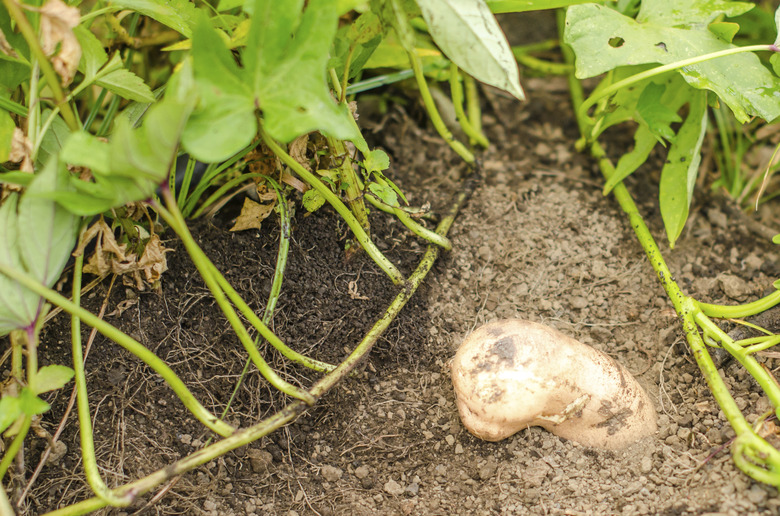Is A Sweet Potato Vine Toxic?
Although most gardeners are familiar with sweet potato vines (Ipomoea batatas) for their edible, smoky-sweet orange tubers, the ornamental sweet potato cultivars put their energy into fountains of deeply lobed or heart-shaped, spring-to-fall leaves. Hardy in U.S. Department of Agriculture plant hardiness zones 9 through 11, the ornamental cultivars' leaves range from neon-chartreuse and warm burgundy to nearly black with some sporting multicolored foliage.
You can grow sweet potato vines as groundcovers, cascading from window boxes, hanging baskets or urns, or trailing over garden walls. The attention-grabbing ornamental leaves, while technically nontoxic, can result in diarrhea if too many are eaten, while ingesting the seeds may cause neurological issues.
Tip
Edible and ornamental sweet potatoes are the same plants with multiple cultivars: one grown for its tasty tubers and the other for its bright, decorative leaves. While the tubers and leaves are edible, eating the seeds is not recommended since they can cause neurological problems in humans, horses and other pets.
Sweet Potato Seed Toxicity
Like annual Heavenly Blue morning glories (Ipomoea tricolor 'Heavenly Blue') and other members of the morning glory (Convolvulaceae) family, ornamental sweet potato vines that flower may produce seeds laced with the toxic and naturally occurring LSD. Most cultivars don't flower, but the ones that do boast lavender or pale-pink trumpet flowers in late summer and early fall.
None of them requires seeds to reproduce; the tubers remain in the ground through the winter and send up new shoots each spring. In zones colder than 9, they're lifted and stored in fall for replanting in spring.
Reduce the Risk
When some ornamental sweet potato's flowers are pollinated, round seed pods form at the bases of the stems where the flowers were attached. The pods shrivel and dry as they age, and the seeds inside ripen. Gardeners concerned about potential poisoning can simply remove the seed pods as soon as they appear and dispose of them where they won't pose a danger to kids or pets.
While the seeds may be toxic, the rest of the plant can be eaten by humans, horses and other pets. As with any other plant matter, eating too many leaves may cause vomiting in dogs and cats. Sweet potato tubers, however, are dried as dog treats. The tubers of the ornamental varieties are not as tasty as the cultivars grown specifically for their tubers, but are also edible.
Signs of Poisoning
Visual and tactile hallucinations are the primary symptoms of eating sweet potato vine seeds. They affect animals as well as people. Other symptoms in people include facial flushing, dilated pupils, lowered blood pressure and diarrhea, numbness of the hands or feet, vomiting and drowsiness. Dogs and cats may also develop diarrhea if they eat too many of the edible leaves.
Treating a Poisoning Victim
If you suspect a person or pet has eaten ornamental sweet potato vine seeds, remove all plant material from and rinse their mouth and hands or paws with water. Wash their hands or paws and mouth, checking for signs of irritation. Even if they show no symptoms, call your local poison control center or pet poison hotline for instructions on the next steps to take. If your local authority tells you to go to the hospital or veterinary clinic, take some seeds with you.
Pets and Induced Vomiting
There is no safe way to induce vomiting in a cat or dog at home. Salt used to induce vomiting may imbalance a your pet's electrolytes or make its brain swell. Feeding the pet mineral oil, butter or grease to speed poison's journey through its digestive tract may cause vomiting violent enough to dehydrate the animal. Finally, cats or dogs inhaling vomit into their lungs frequently contract pneumonia.
